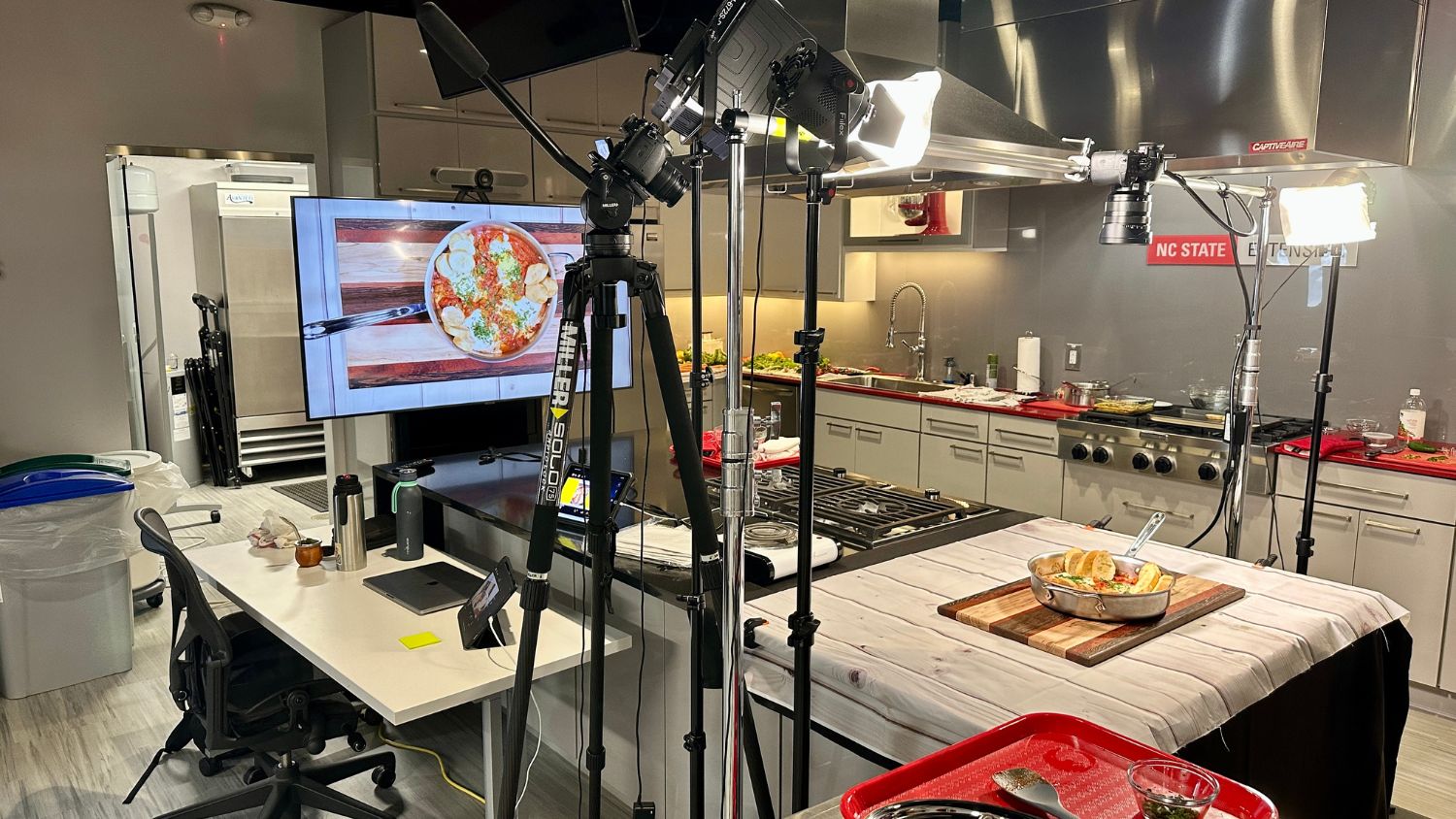
2020 Eloise S. Cofer Lecturer
Cheetie Kumar, 2020 Eloise S. Cofer Lecturer

Cheetie Kumar, chef and owner of Garland Restaurant in Raleigh, NC, is not a stranger to the Department of Agricultural and Human Sciences, having worked in the department before following her culinary passions. She is also a James Beard Best Chef Southeast Finalist – the Oscars of the food world. Chef Kumar’s cooking is filled with imagination and rebellion and is unassumingly delicious. Her Indian heritage merged with her time in New York City and her love for local Southern ingredients makes for unique and delicious food.
2020 Lecture Series Recording
Watch the recording of the 2020 Eloise S. Cofer Family Living Lecture Series to learn more about Chef Cheetie Kumar and her take on two classically southern dishes.
3 Recipes Developed by Chef Cheetie Kumar
Ginger-Braised Collards
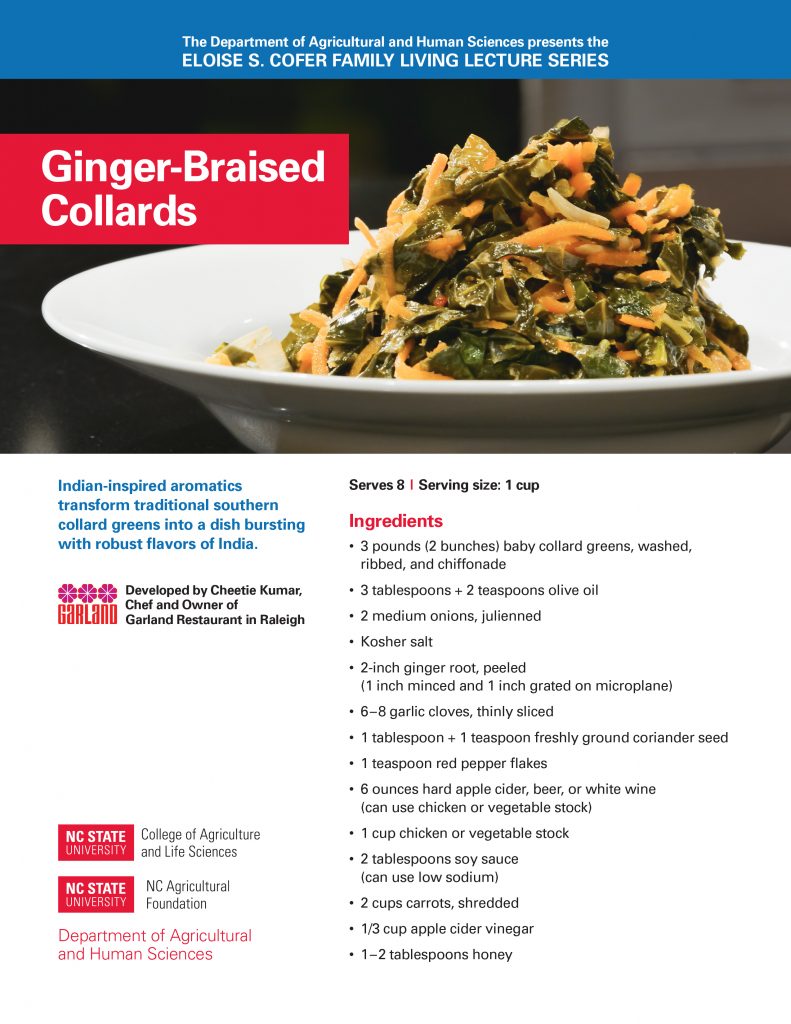

Indian-Spiced Black-Eyed Peas
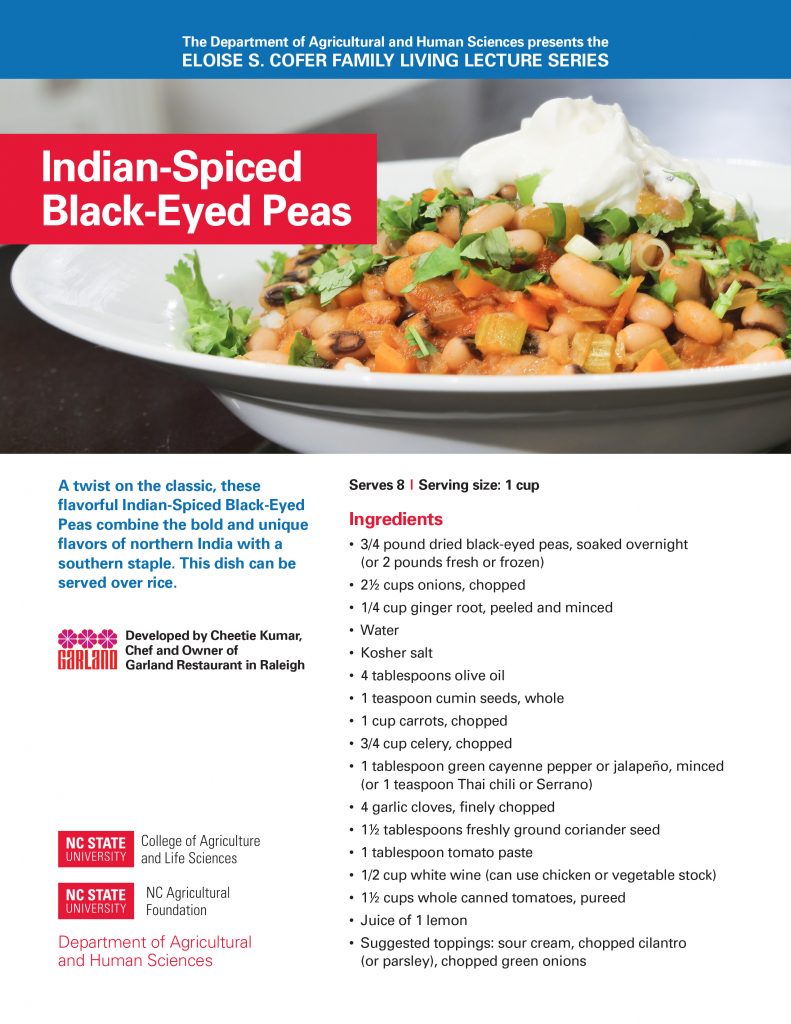
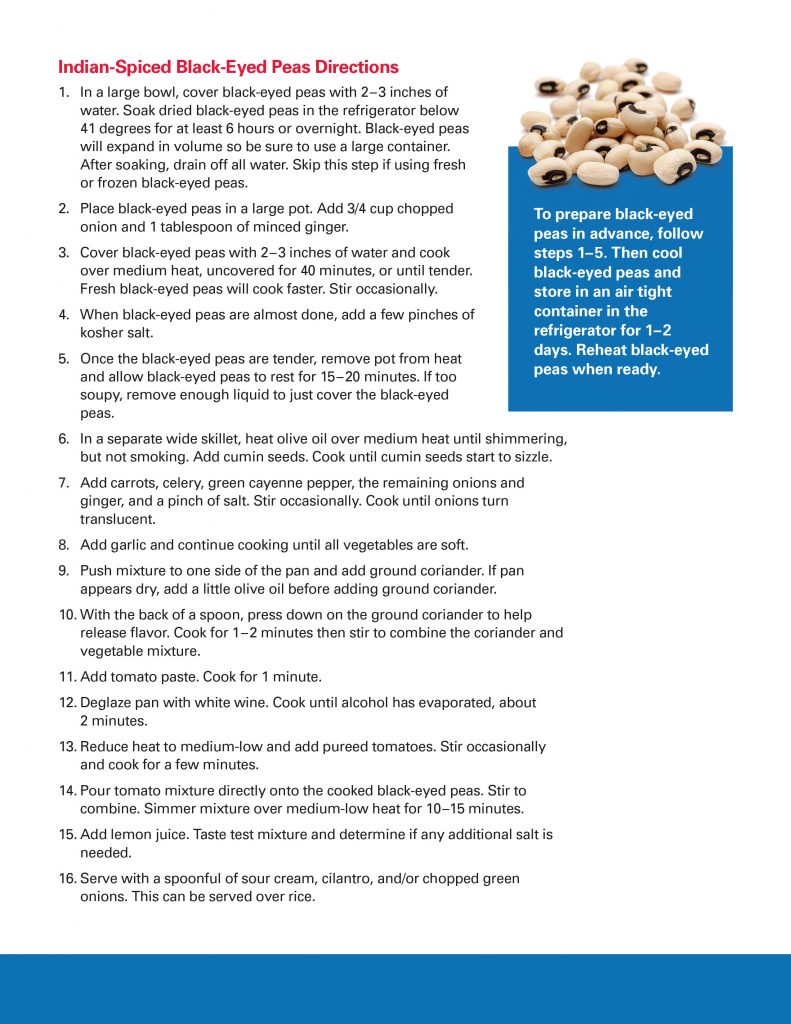
Jasmine Rice
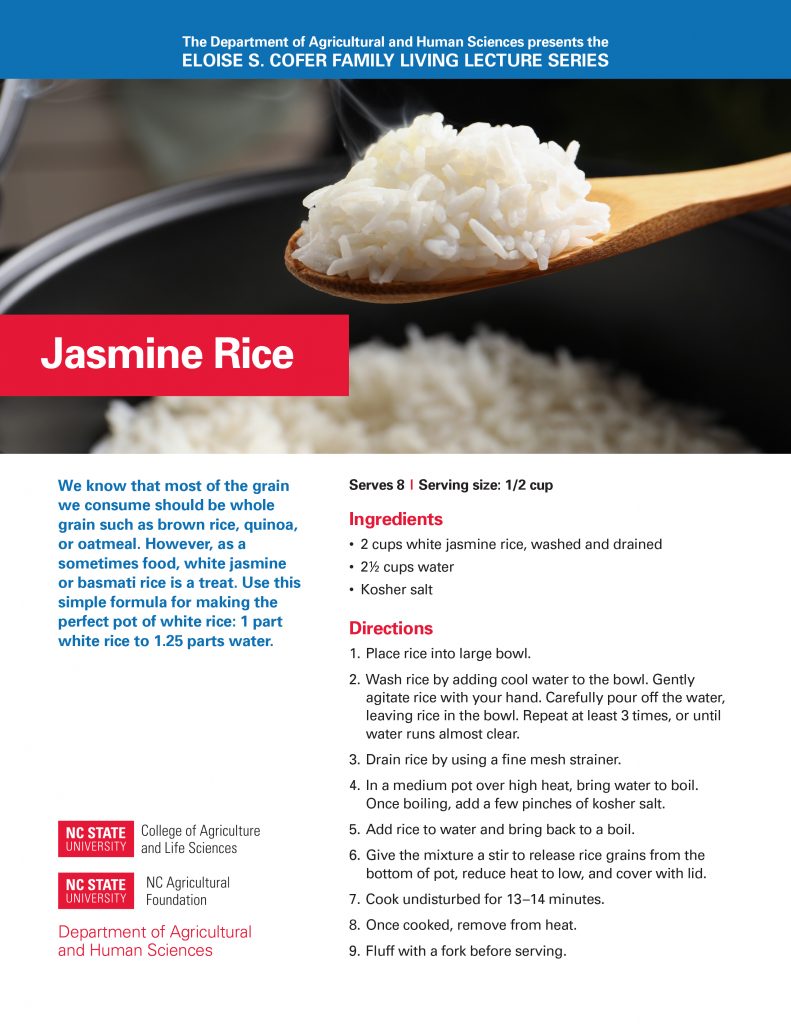
Lecture Q&A
Click on the plus sign to view the answers to the questions.
Say one doesn’t care for onions. Is there anything you can substitute for them? Could you just leave them out of the dishes you just demonstrated or will they not be right?
The great thing about cooking at home is that you can customize recipes to suit your taste and/or dietary needs. Onions play a large role in both of these dishes so eliminating them altogether will certainly change the outcome but could be done.
What are your quick tips on cooking brown rice vs basmati rice?
Brown rice generally takes about 50 minutes to an hour to cook. You can do this in a regular pot on the stove or in an instant pot for 22 minutes on high pressure with a manual release. The general rule of thumb for water is 1.25 cups of water per cup of rice but you should check the label as brands and types of rice vary.
Can you provide more advice on rice? My basmati always ends up perfect, but my jasmine always sticks, no matter how much I rinse it.
If you are using the 1.25 to 1 cup rice ratio, make sure you are being very exact in your measure. Also, you need to quickly reduce the heat after it comes to a boil so the rice does not overcook. If you have an electric cooktop, you may need to move the pot completely off the burner for a minute or two as the eye reacts to you reducing the temp. Also, no stirring or removing the lid until the 14 minutes have passed. Even then, just turn it off and let it sit for a few minutes before fluffing. Good luck – making rice is not as easy as it looks!
What would be the instant pot directions for the greens and black-eyed peas?
You should cook the greens in an instant pot for about 20-30 minutes on high and manually vent. I really don’t recommend instant pot for black-eyed peas but if you do – 15 minutes on high will most likely be enough to get them tender. They do, however, tend to get a bit mushy.
What can we do to help the restaurant industry during this difficult time?
We all have gone through so many waves of emotions during this pandemic. We have all shifted how we do things many times now. It has been really difficult as we all have a conundrum of: how do I keep my doors open and staff paid but also keep my staff and customers safe. I don’t know of a single independent restaurant that is not panicking at this point. Just think of any business not having their normal income for nine months. It is a really trying challenge. The next three months will be the hardest that we have had.
- Take-out: if your favorite restaurant has pivoted to take-out, support them and order take-out. Go to their website and order how they want you to. If they offer delivery, use their delivery service. Don’t go to a third party to order as the commission fees can be really painful.
- Restaurants Act in Congress: this act has passed in the House but has not passed yet in the Senate. This bill would be a game-changer for the restaurant industry. It won’t be as simple as opening our doors and turning on the lights once we can get back to some sort of normalcy. Call your NC Senators. To date, one Senator has supported the bill, the other has not. Share your voice and your concern for the restaurant industry.
- LEE initiative, Restaurant Reboot Relief Program: As restaurants around the country look towards reopening, The LEE Initiative is committed to helping reset the supply chains for farmers and restaurant operators who are committed to sustainable food. The LEE Initiative’s Restaurant Reboot Relief Program is committing at least $1 million to purchase food from sustainable farmers in 16 regions and giving that food directly to restaurants in those areas. If you are able and would like to donate, please visit https://leeinitiative.kindful.com.
What is your favorite thing to make?
When COVID first began, I realized that I had forgotten how to cook at home – when you develop a recipe in the restaurant it is very different than what you would do at home. Overall, I like food and cooking techniques that bring me comfort – braising inexpensive cuts of meat, making a big pot of beans, making pasta, utilizing leftover rice, getting inspired at the farmers market by what is fresh and in season. I tend to crave things that are growing right now. Summer, it is tomatoes – winter it is apples.
Ginger and coriander are used a lot in your cooking. What is it about those ingredients that gets you excited?
Ginger, coriander, and cumin are my go-to’s. I liked them so much because their flavors transform depending on how you use them. For example, in the south most pickling recipes use whole coriander, which lends a citrusy note. When you grind whole coriander seeds and bloom it in hot oil, the flavor transforms to a more earthy flavor. This transformation of flavor happens with ginger and cumin. When we opened Garland we joked that we should be called “The Story of the Migration of Coriander and Cumin”. Both are used in East Asia, South Asia, Middle East, Latin America, South American and we all found the beauty of these spices in unique ways.
The Department of Agricultural and Human Sciences tends to highlight the intersection between food and family. What about food connects you to your family?
Our family moved a lot. My mother was a part of the partition between Pakistan and India. She lost her parents during the move to India and food was a way for her to remember and connect with her own family. When we all moved to America, dinner was very important to us and was a happy time. When I now cook something that my mom used to make it transports me back to those happy times immediately. Many people feel this way – ask someone what their favorite dish is and most answers start by naming a family member. For example, my grandmother’s pie. I feel that food and music are unique in that they can transport us to important memories.
Cooking is a mixture of science and art. Can you talk about your creative process?
When I started cooking professionally, I realized that sitting down to write a song is similar to sitting down to write a recipe. You can get stuck in the middle – you start out with an idea and you start working on it but it doesn’t come out as you imagined. It is at this key point that you just have to keep working at it! Anything that is a creative endeavor requires a little bit of sweat. Recognizing our emotional ups and downs of the creative process is really important so you don’t get bogged down.